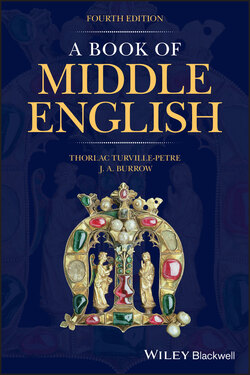Читать книгу A Book of Middle English - J. A. Burrow - Страница 90
6.3 Alliterative Verse
ОглавлениеIn the later fourteenth century alliterative poetry flourished in the hands of some remarkable poets of the West and North‐West Midlands. They are represented in this book by William Langland, the Gawain‐poet, and the author of St Erkenwald (texts 7–11).
The alliterative line is based on principles quite different from those of rhymed verse, but they are essentially easy to understand. Each line is divided into half‐lines bound together by alliteration. Each half‐line normally has two stressed syllables; the two stresses of the first half‐line alliterate with the first stress of the second half‐line, while the last stress does not alliterate. So, with a standing for ‘alliteration’, the standard alliterative pattern is denoted aa/ax:
þe túlk þat þe trámmes . of trésoun þer wróʒt
Watz tríed for his trícherie . þe tréwest on érthe
Hit watz Énnias þe áthel . and his híghe kýnde (9/3–5)
In the practice of these poets, any vowel may alliterate with any other vowel and with h‐, as in the last line quoted.
This structural alliteration normally falls on stressed syllables. As already described in 2.4, the way a word is stressed in Modern English is generally a good guide to its Middle English stress‐pattern, although there are some variations, particularly in French loan‐words. So ‘deserved’ alliterates and is stressed on the first syllable in
Such a dúnt as þou hatz dált . dísserved þou hábbez (9/452)
‘Important’ words (nouns, adjectives, adverbs and verbs) are normally stressed in preference to ‘little’ words (prepositions, articles and conjunctions). When an adjective accompanies a noun, either may be stressed, as the following line illustrates:
Of brýʒt golde upon silk bórdes . bárred ful rýche (9/159)
Sometimes there are three alliterating syllables in the first half‐line. It may be appropriate to subordinate one of these, so that in the following the first word, siþen, is presumably unstressed, though alliterating:
Siþen þe sege and þe assaut . watz sesed at Troye (9/1)
Yet it is more difficult to subordinate the noun borʒ in the next line:
þe borʒ brittened and brent . to brondez and askez (9/2)
Non‐standard alliterative patterns, such as ax/ax or aa/xx, are also found, but many of them are perhaps the result of scribal error. An obvious example of such corruption is:
Wolde ʒe worþilych lorde . quoþ Gawan to þe kyng (9/343)
where we have adopted the simple emendation to Wawan, a form of Gawain’s name used elsewhere by the poet, to restore the standard alliterative pattern.
A stressed syllable is called a lift, a group of unstressed syllables a dip. The dips vary in length, and this determines the rhythmic structure of the half‐line. In the following two lines, the first has a four‐syllable dip before the first stress, while the next has no dip at all between the stresses of the second half:
þat siþen depréced próvinces . and pátrounes bicóme
Wélneʒe of al þe wéle. in þe wést íles (9/6–7)
A dip of one syllable may be called ‘weak’, and ‘strong’ if it is more than one syllable. In the second half‐line (the ‘b‐verse’) the rhythm is quite tightly controlled, with a maximum of eight syllables and a minimum of four. Furthermore, one of the dips preceding the two lifts must be strong, the other must not be strong. So in the b‐verse of l. 6 above, the first dip (‘and’) is weak, the second is strong; in l. 7 the first stress (‘west’) is preceded by a strong dip, and followed immediately without a dip by the final stressed syllable. If there is a dip at the end of the line it is always weak. For a fuller account, see H. N. Duggan in Derek Brewer and Jonathan Gibson, eds, A Companion to the Gawain‐Poet (Cambridge, 1997), pp. 221–42.
In Sir Gawain and the Green Knight, from which all these examples have been taken, a varying number of alliterative lines is rounded off by a rhyming ‘bob and wheel’ of five lines, the ‘bob’ of one stress and the four lines of the ‘wheel’ of three stresses.
The basic description of the alliterative line applies also to the verse of Piers Plowman, but the variations in Langland’s line are considerably greater than those in the Gawain‐poet and the other writers of the North‐West. One very characteristic feature of Langland’s verse is the alliteration of an unstressed syllable before a non‐alliterating stressed syllable. So in this second half‐line, fro alliterates but morw‐ is stressed:
And flápton on with fláles . fro mórwen til éven (7b/180)
Variant alliterative patterns, in particular aaa/xx and aa/xa, are found quite frequently in Piers Plowman and are perhaps authentic, but scribal intervention in this text is a major problem, and many of the metrical anomalies may be a result of corruption.
